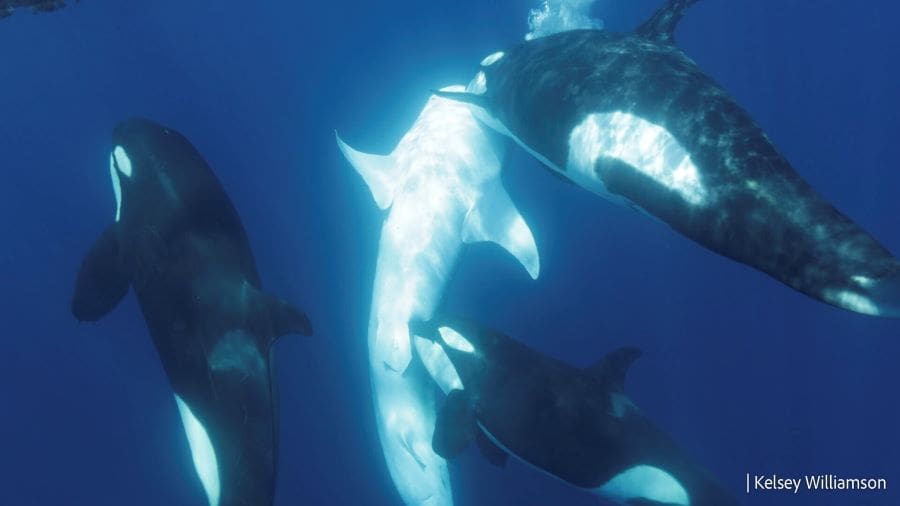Killer whales, renowned as apex predators of the oceans, have been observed hunting and consuming whale sharks, the largest fish on Earth.
A new study published in Frontiers in Marine Science details four predation events recorded between 2018 and 2024 in the southern Gulf of California. The findings highlight the orcas’ strategic approach to targeting these ocean giants, focusing on the pelvic area to incapacitate their prey and access nutrient-rich organs. Researchers also identified an adult male killer whale, nicknamed Moctezuma, involved in most of the events, suggesting a potentially specialized pod of whale shark-hunting orcas in the region.
Deborah Pirchner | Frontiers – Researchers observed four hunting events in the Gulf of California where orcas preyed on the world’s largest fish, whale sharks. In coordinated attacks, they targeted the sharks’ pelvic area, causing them to bleed out, and giving the orcas access to the liver. Orcas behaving this way could mean there is a specialized pod of hunters in the Gulf of California.
Killer whales can feed on marine mammals, turtles, and fish. In the Gulf of California, a pod might have picked up new skills that help them hunt whale sharks – the world’s largest fish, growing up to 18 meters long.
Whale sharks feed at aggregation sites in the Gulf of California, sometimes while they are still young and smaller. During this life-stage, they are more vulnerable to predation, and anecdotal evidence suggests orcas could be hunting them. Now, researchers in Mexico have reported four separate hunting events.
“We show how orcas displayed a collaboratively hunting technique on whale sharks, characterized by focusing on attacking the pelvic area causing the whale shark to bleed out and allow orcas access to the lipid-rich liver,” said Erick Higuera Rivas, a marine biologist at Conexiones Terramar and senior author of the Frontiers in Marine Science article. “One individual was engaged in three of the four events, alongside with other members who might belong to a pod specialized on hunting on sharks.”
Specialized hunters
The predation events occurred between 2018 and 2024 in the southern Gulf of California and were captured in images and videos taken by members of the public and scientists. Individual orcas were identified by analyzing photographs of dorsal fins and distinctive features like scars.
In three of four hunting events a male orca called Moctezuma was present. A female orca previously observed in the presence of Moctezuma participated in one event also, suggesting they could be related or members of the same pod.
“When hunting, all pod members work together, hitting the whale shark to turn it upside down. In that position the sharks enter a state of tonic immobility and can no longer move voluntarily or escape by going deeper,” Higuera Rivas explained. “By keeping it under control, the orcas then have greater ease and speed in approaching the pelvic area of the shark and are able to extract organs of nutritional importance for them.”
Orcas may be targeting whale sharks’ ventral side because there their bodies are thought to be the least protected. For example, there is less muscle and cartilage in this area, allowing easier access to the aorta. Although whale sharks’ livers are an important part of orcas’ diets, there was no photographic observation of the orcas consuming the organ.
Hunting this way could imply that some orcas in the Gulf of California have acquired special skills that help them prey on whale sharks. In other regions, orcas may have learned to do the same thing, but evidence is limited, the researchers said.

Understanding how orcas hunt
Collecting the data the scientists needed wasn’t easy. Attacks cannot be predicted, access to images and videos can be limited, and image quality is oftentimes too low to reliably identify animals.
Despite this, the researchers said their finding could have several implications. The fact that there is a whale shark hunting pod in the Gulf of California increases the need for managing marine adventurers and tourists, the researchers cautioned. “There must be a specific regulatory norm that guarantees that any type of non-extractive use activity is carried out in a respectful and sustainable manner,” Higuera Rivas said.
Further, if the thesis that Moctezuma and his pod have acquired ecological and behavioral information for hunting whale sharks in the Gulf of California holds, the pod could be vulnerable to a possible disappearance of this specific prey due to climate change within the region.
Ultimately, new information related to these orcas helps researchers gain a greater understanding of their adaptations unique to their needs and geographical location. “It is very impressive how orcas work together strategically and intelligently to access only a very specific area of the prey. It highlights what great predators they are,” concluded Higuera Rivas.
Journal Reference:
Pancaldi F, Ayres KA, Gallagher AJ, Moskito J, Williamson KC and Higuera Rivas JE, ‘Killer whales (Orcinus orca) hunt, kill and consume the largest fish on Earth, the whale shark (Rhincodon typus)’, Frontiers in Marine Science 11: 1448254 (2024). DOI: 10.3389/fmars.2024.1448254
Article Source:
Press Release/Material by Frontiers
Featured image credit: Dianne Maddox | Pexels



